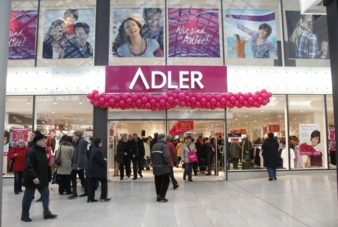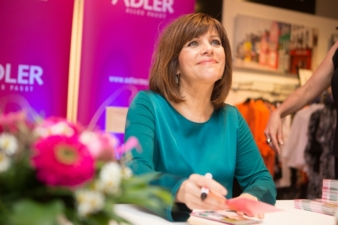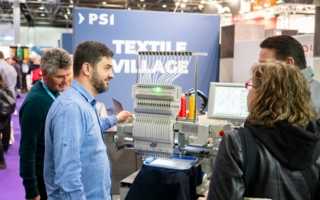13/03/2015 — auf Deutsch lesen
Adler: Making progress
Adler first became involved with RFID technologies in 2011. Following an extensive pilot phase, in which the company initially selected suitable system partners for its specially-tailored project, Adler began its company-wide rollout in August 2013 – with great success.
Many people, however, still consider the textiles supplier – which operates around 170 large retail stores throughout Germany, Austria, Switzerland and Luxembourg – to be just a discount store for old people. Lothar Schäfer, Chairman of the Executive Board at Adler, said: “Those who are unfamiliar with us tend to have a negative opinion of the company. In terms of brands, product selection and store facilities, we have become much more modern.”
Schäfer and his 4,300-strong team would surely fall short if they were to try to overcome these recognised shortcomings solely with a new, running advertising campaign – albeit a very successful one. For this reason, Adler’s current Executive Board has also made changes in a number of different areas within the company. When Schäfer joined Adler in 2009, he first had to undo the failed rejuvenation strategy which had been instigated by his predecessor under the auspices of the company’s previous owner, Metro AG. Through this strategy, Adler had lost sales and had begun to make losses. In the end, Metro AG was no longer happy with its subsidiary and sold the company. Schäfer and his management team put a stop to these undesirable developments and turned their thoughts to Adler’s brand image.
The textiles chain was a specialist for a target demographic aged 45+, but in reality their customers had an average age of around 60. The company’s greatest strengths were primarily expertise in fitting and a product range which was strongly oriented towards its loyal customer base. It was considered necessary to revitalise these strengths while also winning back lost customers. The management was aided in this endeavour by the Adler loyalty card, which had been introduced in 1974, one of the oldest customer retention tools in German retail. Adler generated around 90 percent of its sales through the loyalty card and the company’s knowledge of customer addresses and purchasing habits gained from the loyalty scheme was decisive in regaining lost ground.
These efforts were rewarded with renewed success and a successful stock market flotation in June 2011. This was followed by a period of rapid expansion with smaller acquisitions and a number of new Adler store openings. The management then began to consolidate the existing store network and to shift focus onto strengthening earnings. Executive Board Chairman Lothar Schäfer and his Finance Executive Karsten Odemann supported this successful, three-pronged strategy of target group marketing, image change and earnings growth with a technological offensive.
This is how Adler first came to be involved with RFID technologies in 2011. Following an extensive pilot phase, in which the company initially selected suitable system partners for its specially-tailored project, Adler began its company-wide rollout in August 2013. This ambitious investment project was successfully completed just a few weeks ago. RFID technology was implemented into the inventory management and item labelling systems in all 170 Adler stores across four countries. “Not only is it one of the first in Germany, but it is also the most comprehensive and complex system of its type in terms of scope and implementation so far,” explained Martin Gliesche from system partner Tailorit, based in Düsseldorf.
This investment to the amount of approximately 8m Euro will be recouped by the end of 2015 through increases in earnings, efficiency and customer satisfaction. According to Adler’s previous findings, it could also potentially increase EBITDA by up to 4.5m Euro. Additionally, the newly-implemented technology provides a basis for future, automated process steps in internal product logistics. The equipment includes antennae for logging items delivered from the warehouse, RFID tags for individual items, RFID printers, a new generation of handheld devices for monitoring items in store, as well as software. The project has now been completed around five months after its inception.
There are many diverse, interconnected benefits to the new system. RFID technology allows Adler to precisely monitor in-store inventory at any time, with immediate notification from the store warehouse as soon as an item or size is sold out. This also allows for items to be restocked from the central warehouse as soon as in-store stock levels fall, which results in increased sales as instances where popular items may go out of stock can be identified and managed more quickly. The technology also enables waiting times to be shortened through quicker checkout processes, item security to be considerably increased through integration in RFID tags, and all processes involved in inventory management and the supply chain to be improved in general.
In this regard, Executive Board Chairman Lothar Schäfer added: “We have invested a lot of time, energy and money in this project. However, the sum of all its benefits as well as the rapid return on investment convinced us to go ahead with the project. It is not only the company, but also the customers, who will benefit from these improvements in our processes.” From improved stock levels of fast-selling items alone, Schäfer estimates a potential increase in sales of up to 2.5 percent. Realistically, this increase in sales will be determined by comparing the sales of normal product ranges with NOS ranges, which were sorted using RFID.
Alongside better item availability for customers, the inventory management system stands out for its improved item security and its ability to constantly monitor levels of stock. “The use of cumbersome hard plastic tags is no longer needed, and we will be able to reduce our present inventory differences of around 1.3 percent by approximately 25 percent,” believes Schäfer. Adler has already made good progress in 2014. The first quarter, which is traditionally the worst of the financial year for the fashion industry, was significantly better than in previous years. The company was within its target range in the second quarter as well. “From my experience, the fashion business is still unpredictable,” said Schäfer.





